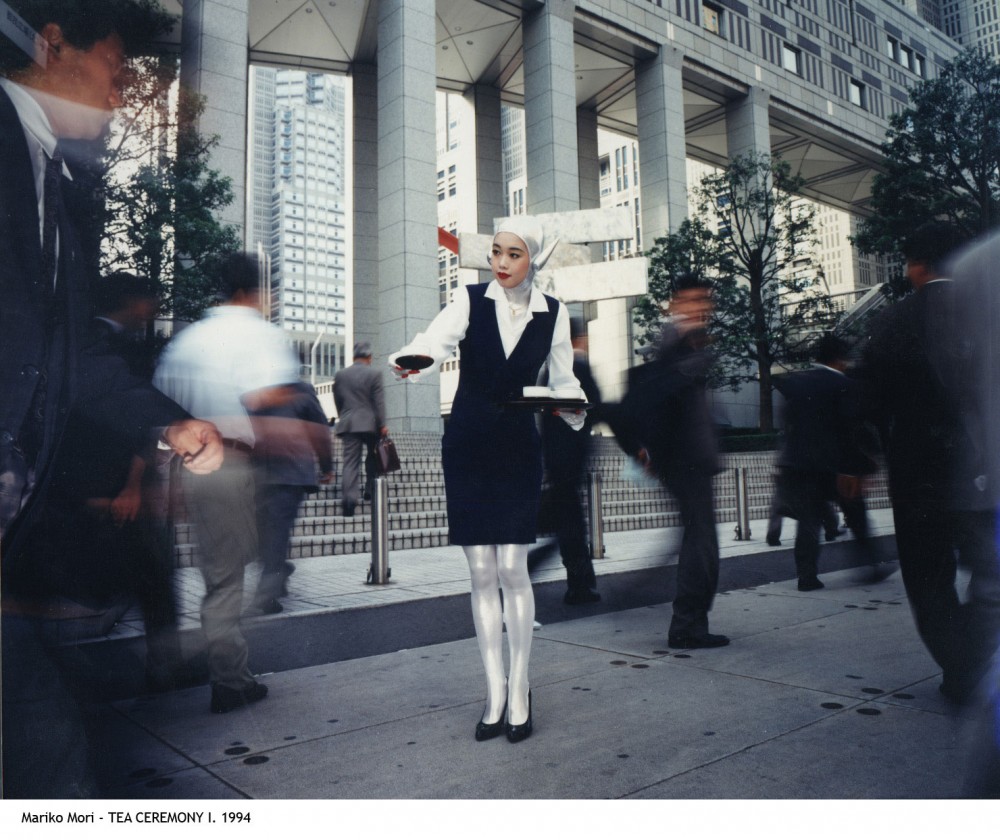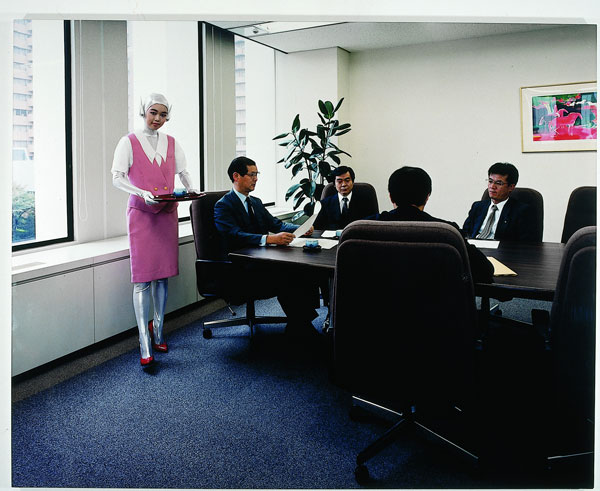Andrea Blanch: Transitioning from model to artist must have been an interesting journey. When you were a model, were you also an artist who happened to be working as a model or were you a model who discovered art? Mairko Mori: I cannot really answer straight away because when I started modeling, I was 16 so I wouldn’t know about art. But after visiting London, when I was 19 years old, I discovered art. I started creating around 23, 24. I was an art student producing artwork.
Your work is often shown in public with yourself playing the role of an outsider. Are you playing a role or do you feel disconnected from society like the aliens or toys you embody?
Well, it is a metaphor. I think you’re referring to my early work. It is a metaphor to have an objective point of view and sometimes it’s a metaphor for an outsider. Sometimes it’s a metaphor for going to newer contexts. Living everyday life and as an artist, we have quite a unique position in society.
We are able to observe the world in a more international and global point of view, and not necessarily be part of one society or one country. You have a better overview of the world because of that reason.
When did you start becoming interested in aliens, robots and spaceships? Is it from your childhood toys or did you come to this later in life? Is it a cultural indoctrination?
It’s cultural, the popular culture in Japan where I grew up. It coincided with the economical growth of Japan. So in the 60’s and 70’s, people were very excited to think about the future. The image of the futuristic idea was significant at the time.

You seem interested in the rise of technology and humanity, together. Do you feel like technology is coming at the cost of our humanity or enriching it?
I think the science technology is helping us in human’s curiosity. We cannot forget that technology and science is a reflection of the human mind. The human is creating a technology in order to reflect a human’s mind. I think this is very important to know.
Do you think we are alone in the universe?
If we consider the latest theory of multi-universe, parallel universe and renewal of the universe, none of those new theories suggest that we are alone in a universe.
You explore spirituality and mysticism. How do you view your gods?
Everything is connected and everything is related. All nature, every planet in the galaxy, this universe or even the multi-universe, everything has a relationship. I feel that’s how everything is connected.
Your work Oneness is Buddhist or Shinto. Were you raised in a religion?
Shintoism—the goal is to live in everything that is living nature. This is really to give a lesson to the people to honor and respect nature. Everything from ants to the multi-universe, there’s good in it. It’s important to respect. It’s very morally oriented with a spiritual aspect to it. It’s about seeing the connection. It seems to me that Shintoism and Buddhism emerged, and those religions are able to show you a concept together.
Does kinetic sculpture influence your model work? Where do you find your inspiration?
I started doing more installation work since 1999, which is already 15 years ago. I was more inspired by a 16th century tea master and how he expressed his idea by using every sense; such as visual, tactile or from sound scent and space. So every sense as a human being was being stimulated by his concept and his idea, which I think was very interesting and a great addition to creating art work. So I believe this is one of my inspirational figures.

What has inspired you lately?
The most recent exhibition was organized in Japan, and focused on our society and our economy last year. I was inspired by pre-historical culture. So I really made a prehistoric argument to coincide with what was going on in Japan at that time. I read and did some research. Sometimes I went to city researchers, scientists or a tea master. Everything I see influences me, and especially quite recently, nature was very influential. The natural world became part of my landscape and so on.
If you could actually become one of your creations: a mermaid, alien, cyborg, which would you choose?
Those characters are kind of symbolic in certain concepts in the work and sometimes those are magical. I only wish to be myself.
How important is it to you that the audience interacts with your work?
The recent work that I created has an interactive aspect. So it’s one of the elements that I investigate and explore. When the audience interacts with the work, the audience becomes a part of the artwork. How the artist sees the world—sharing the idea of oneness is very important that the audience becomes a part of the artwork. The concept of oneness is really individual. The individual has to break the boundaries between self and others. Your body is a boundary between your mind and the world outside of your body. So, that’s why it’s good if I welcome the audience to be a part of the work, which helps to liberate their own body to be connected to the whole.
Historically, how would you like your work to be perceived?
History always becomes the edited version of the past and it’s never really fixed. The future can change the past, too. It’s a bit relevant to the position at the moment, this way the performance work is quite interesting; sharing time, moment to moment and it disappears. It doesn’t stay as an object it’s just an experience that we have. So I was interested in power over the performance in that kind of way because history is a man-made and edited version, it can never be fixed. Living in the moment is the most relevant and important thing at this moment.

When art historians talk about your work in the future, what would you like them to say?
That’s the only way to survive, through time and space, in order to communicate with the future generation. So I don’t know what the art historian would say about my work, but I would like to achieve the quality of the work that can transcend time.
What is your feeling about art being taken to the streets to punctuate the point. Do you feel that the point can be made without any context? Do you think people without knowing what is happening can really understand what they’re looking at?
If you don’t know the context, you don’t understand what’s going on. That’s why performance work is different etc., you know the context so you know what’s happening. It has a performance aspect but the work itself is the documentation of the performance within the context.
The viewer understands the context through the work, but not the actual people that are in the photograph; that is not the context, she doesn’t understand, you have to know the context to understand.
This issue that we’re doing is on fantasy. What is your latest, personal fantasy?
I think the internet, Skype, that’s how we connected with each other. We don’t have the limitations. What it seems to me is that it’s easier to be connected. So my fantasy is that that the concept of oneness can really be understood through out the whole world. That we bring earth consciousness to our mind, to really have a feeling of sharing this world together with everybody on earth.

